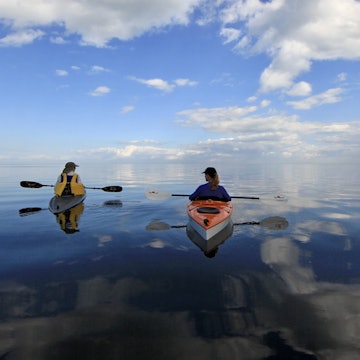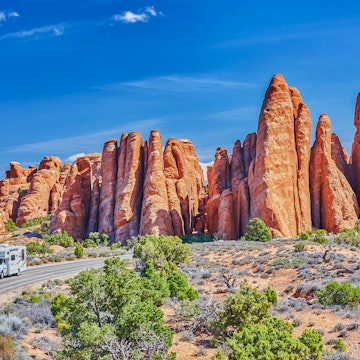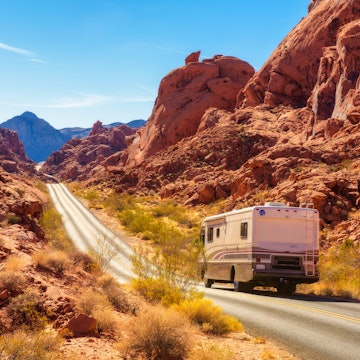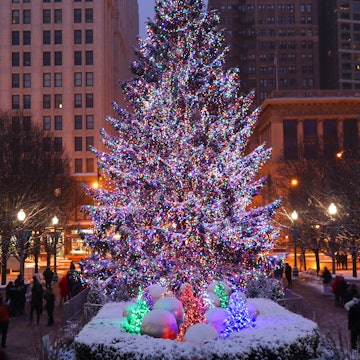
Find the perfect spot in the US for your next stargazing adventure

Apr 18, 2023 • 4 min read

See the Milky Way over Rainbow Bridge National Monument © Ralph Ehoff / Getty Images
There are few sights as awe-inspiring as the night sky, with the cloudy band of the Milky Way and the planets shining overhead. While most people travel for daytime sightseeing or adventure experiences, there are plenty of reasons to plan extra time into your vacation to enjoy stargazing in the USA.
This week (April 15 - 22) marks International Dark Sky Week. Organized by the International Dark-Sky Association (IDA), which works with destinations around the world to certify the quality of their dark skies, this week is designed to raise awareness about the light pollution. If you want to celebrate by seeing some of the best skies in the USA, all of these parks are certified by the IDA as dark sky places and are great spots to catch a celestial show. Based on what else drives you to explore the world, here’s how to choose the best one for you.
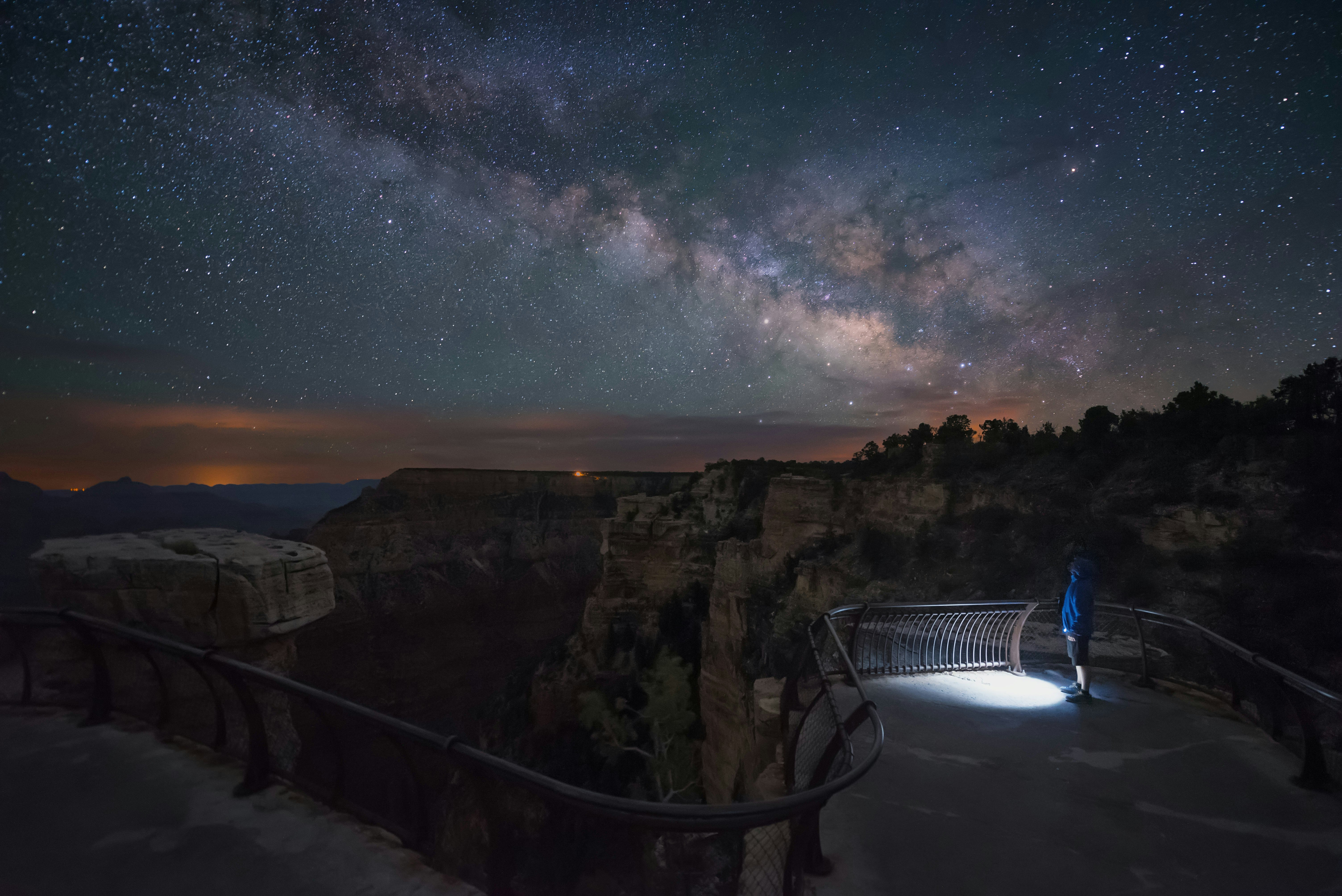
Best for hiking: The Grand Canyon, Arizona
Hiking along the rim of the Grand Canyon, or down in its depths, is a bucket-list-worthy adventure. It’s home to a variety of trails you can enjoy during the day, and once the sun sets you can spend your evenings attending organized astronomy events. There’s usually a variety of ranger talks, constellation tours, and star parties where local astronomers bring their telescopes to set up at the visitor centers on the north and south rim.
How to visit: There are three campgrounds, an RV campground and a wide variety of accommodations available near both the north rim and south rim of the Grand Canyon. Reservations are required at least several weeks in advance.

Best for families: Cherry Springs State Park, Pennsylvania
If young members of your family are interested in the night sky, Cherry Springs State Park in Coudersport, Pennsylvania is a great option. This state park is small at just 1.7 square miles but represents one of the best pockets of darkness near the east coast. It plays host to multiple programs on weekend nights when park educators or guest speakers introduce the wonders of the night sky and natural world at night to all ages.
How to visit: Cherry Springs is about 4 hours from Pittsburgh or 4.5 hours from Philadelphia. During the summer months, you can camp overnight at one of 30 sites in the park, but they fill up fast so make your reservation online before you go.
Best for solitude: Rainbow Bridge National Monument, Utah
Near one of the most sparsely populated areas in the contiguous United States, Rainbow Bridge National Monument is a certified Dark Sky Sanctuary. You’ll need to plan ahead to go stargazing: there are no roads where you’re going. The only way to reach the namesake rock formation is with a backcountry hiking permit administered by the neighboring Navajo Nation.
How to visit: Camping at Rainbow Bridge is not permitted—you’ll need to hike in to go stargazing and then hike back out to a designated campsite on Navajo Lands. It’s best to visit the Lake Powell Navajo Tribal Park office in Page, Arizona, and confirm where you can camp.

Best for amateur paleontologists: Dinosaur National Monument, Colorado and Utah
Spend the day exploring dinosaur fossils dating back 150 million years; at night, gaze at stars whose light has traveled the same amount of time. Straddling the border between Colorado and Utah, you can ponder the vast history of the universe through the geologic record that is so well-preserved in this park. There are also human petroglyphs for those who want to learn history that’s a little more modern.
How to visit: There are six campgrounds within Dinosaur National Monument; some are located within hiking distance of fossils or petroglyphs. More adventurous travelers can raft down the Green River from the Gates of Lodore campground; backcountry spots along the river are reserved for this, and are the most remote parts of the National Monument to ensure dark skies.

Best for urban stargazing: Homer Glen, Illinois
It might seem like you’ve got to prepare for a multi-night journey to stargaze in the most remote parts of the country. In fact, there are dark sky places closer than you might think. Homer Glen is home to 25,000 people and only an hour from downtown Chicago. It’s certified as a Dark Sky Community and hosts semi-regular stargazing events for residents and visitors alike.
How to visit: If you’re staying in Chicago, book a room at the historic Plaza Hotel. You’ll look out over Millennium Park and it’s an easy walk to the Adler Planetarium to learn more about the wonders of the universe.

Best for going off the grid: Cosmic Campground, New Mexico
If the idea of going off the grid is your ideal escape, there’s a dark sky park for that. Cosmic Campground was the first certified Dark Sky Sanctuary in the northern hemisphere. A sanctuary is usually very remote, with few (if any) nearby threats to its darkness. Because of its remoteness, it needs advocates. And the Sanctuary designation helps to get the word out.
Located under some of the darkest skies in the US in western New Mexico’s Gila National Forest, Cosmic Campground is basic: there are only pit toilets and no water or trash services at the campground, and you can only use red lights outside after dark. This commitment to living rough ensures all visitors enjoy the pristine night sky.
How to visit: Cosmic Campground currently has five campsites available for RVs, trailers or tent camping on a first-come, first-served basis.








